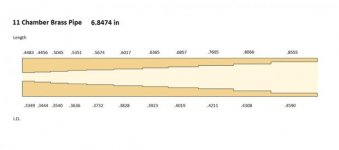Hello,
I'm looking for advice in manufacturing (several) stepped bore brass pipes as shown in picture. The problem is that I don't have access to CNC machines but I'm able to rent some time to work with lathe if needed.
I also have drill press at my garage so I was wondering if it would be possible to order custom made reamer that could produce the stepped design at once? I'm worried about if the tolerances would suffer greatly and if it's even possible to ream a pipe this long. Any recommendations?
Please be patient as I'm total beginner in machining. Thanks!

I'm looking for advice in manufacturing (several) stepped bore brass pipes as shown in picture. The problem is that I don't have access to CNC machines but I'm able to rent some time to work with lathe if needed.
I also have drill press at my garage so I was wondering if it would be possible to order custom made reamer that could produce the stepped design at once? I'm worried about if the tolerances would suffer greatly and if it's even possible to ream a pipe this long. Any recommendations?
Please be patient as I'm total beginner in machining. Thanks!




